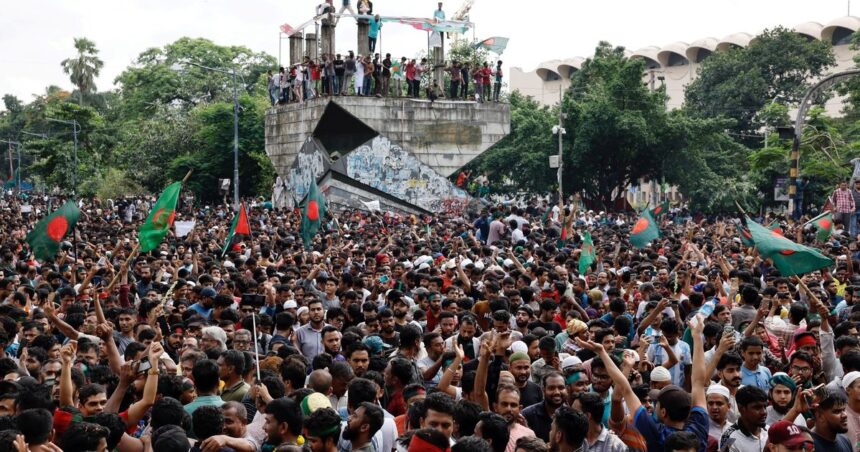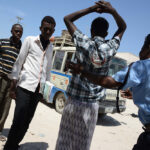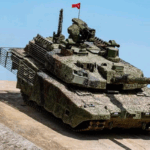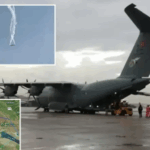Summary by Geopolist | Istanbul Center for Geopolitics:
The Council on Foreign Relations (CFR) blog post titled “How Protests Ousted Sheikh Hasina and Now Bangladesh Faces Dire Danger” explores the political crisis in Bangladesh, detailing the events that led to Sheikh Hasina’s ousting and the resulting challenges facing the country. Here’s a detailed summary:
Background
- Political Turmoil and Protests: The blog post outlines how widespread protests and political unrest led to the removal of Sheikh Hasina, Bangladesh’s Prime Minister. The protests were driven by public dissatisfaction with Hasina’s government, which was accused of corruption, electoral fraud, and authoritarian practices. The movement gained momentum as opposition groups and civil society organizations rallied against her administration.
- Sheikh Hasina’s Ousting: The protests reached a peak when they led to significant political instability, ultimately resulting in Hasina being removed from power. The blog details how the protests were marked by clashes between demonstrators and security forces, leading to a volatile and dangerous situation.
Current Challenges
- Political Vacuum and Uncertainty: The ousting of Hasina has left Bangladesh in a state of political uncertainty. The blog discusses the challenges of forming a stable interim government and the potential for power struggles among various political factions.
- Economic and Social Impact: The instability has had severe repercussions on Bangladesh’s economy and social fabric. The blog highlights concerns about economic disruptions, including impacts on business and investment, as well as the potential rise in social unrest and violence.
- Human Rights and Security Concerns: The blog raises concerns about human rights violations and the overall security situation in Bangladesh. There are fears of increased repression and crackdowns on dissent as various factions vie for control.
International Reactions and Implications
- Global Response: The international community’s response to the crisis is discussed, including calls for peaceful resolution and support for democratic processes. The blog notes the varying reactions from different countries and organizations, highlighting the global concern over the situation in Bangladesh.
- Implications for Regional Stability: The blog considers how the crisis in Bangladesh might affect regional stability, particularly in South Asia. The potential for spillover effects, such as increased migration or regional tensions, is examined.
Conclusion
The blog post concludes by emphasizing the dire situation in Bangladesh and the urgent need for international support and intervention to help stabilize the country. It calls for efforts to address the underlying causes of the unrest and to support a peaceful and democratic resolution to the crisis.
Overall, the post provides a comprehensive overview of the political crisis in Bangladesh, the factors leading to Sheikh Hasina’s ousting, and the significant challenges the country now faces.
Read more below.
What’s Next for Bangladesh?
After an escalating round of protests in Bangladesh in recent months, longtime leader Sheikh Hasina, who had fought back many prior demonstrations, has resigned and left Bangladesh, according to the army chief. Although many Bangladeshis have been angry at Hasina’s heavy-handed rule for years, this fury came to a head this summer. After Sheikh Hasina and her long-ruling, increasingly authoritarian Awami League seemingly crushed a first round of protests related to set asides for relatives of independence war veterans several weeks ago in Bangladesh, through massive arrests, torture, and murders, there was a degree of forced calm in the streets of Dhaka and other parts of the country. In addition, the government thought it had potentially addressed part of the root causes of the protests, as the top court reduced in July the number of jobs allocated to relatives of people who fought in the Bangladesh war of independence, a system that had turned into a major source of political patronage for Hasina and her party.
But Hasina and the government were wrong. Revulsion at the initial brutal crackdown—the thousands of arrests, the obvious torture, the extrajudicial killings, the security forces storming into hospitals to grab people or harm them— combined with years of frustration at Hasina’s aloof, brutal, and ineffective rule led to a larger, increasingly high-stakes round of protests this past weekend. Huge crowds gathered in Dhaka and other parts of the country, and this time the demands were not just for changes to the laws about set-asides for families of veterans or other more specific issues, but broad protests against the regime and Hasina herself, who had once been known as a democrat but in recent years had devolved into one of the most repressive leaders in South Asia, and Bangladesh had become a dangerous environment for journalists, writers, artists, university students and professors, opposition politicians, and anyone else who questioned Hasina and her party.
This time around, this past weekend, the growing and increasingly angry protests, focused on the rising authoritarianism, weak economy given Bangladesh’s potential, and specifically on dumping Hasina, could only be solved by Hasina stepping down, or by her and her regime moving into an even higher level of violence. Such a higher order of violence would have led the military and security forces into massive bloodshed of their own people and possible destruction of the capital, parts of which are already burning.
It appears that the security forces were not willing to go along with even broader murder, as so many people rallied in the capital and other parts of the country. Protestors marched in large numbers toward Hasina’s residence, and the army, which always has played a sizable role in Bangladesh politics but has not wanted to place itself in the middle of this crackdown, was forced to choose how to respond, even if, for several pained hours, Hasina, who surrounds herself with a tiny group of advisors, seemed unwilling to leave or unable to understand she had to leave to cool the situation.
Finally, later in the afternoon Monday (Bangladesh time), after fifteen years in power, and as demonstrators had made it into her palace, Hasina resigned and fled to India in exile, causing massive festivities in the streets of Dhaka and other parts of the country. The army took over in the interim. The country’s army chief General Waker-Uz-Zaman addressed the nation on television and said that a transitional government would soon follow. He did not provide specifics on how the army would form this interim government, but promised the country that justice would be pursued for those killed during protests. Zaman also, according to the Guardian, announced that there would be an investigation into the deaths during the crackdowns. He also put in place a curfew for the rest of Monday, though people were still cheering on the streets.
A curfew was put in place on Monday and offices and factories were closed but protesters have still taken to the streets. Bangladeshi TV channels showed jubilant demonstrators dancing and chanting at locations across Dhaka, though there also has been looting and some burning of cars and other similar types of violence.
As reports emerge that Hasina has landed near Delhi, she leaves behind a country with so much promise and which she has hampered in so many ways, from throttling what was once a vibrant political culture and civil society to undermining an economically vital garment sector and also hurting the possibility of boosting the economy by attracting more multinational investment in other sectors. She herself destroyed her own political capital in the years in which she squandered her democratic legitimacy. The country is torn against itself, Islamists have more power today, and Bangladesh’s political culture is even more violent and dangerous than it was twenty years ago. (Hasina claims that this is it—she will not mount a political comeback.)
What’s more, while the military has promised an interim government and then an election, it has a long history of interfering in politics, and there is no certain guarantee they will leave this time; there is also an increasing trend in South and Southeast Asia in recent years of growing military meddling in politics. In addition, increasingly powerful and growing Islamist groups also will be a force to reckon with in a future Bangladesh, and they are plenty dangerous as well. With Hasina gone, her legacy will take some time to be overcome, if it can be overcome at all, and she leaves the country’s politics and economy in a perilous state.
By: Joshua Kurlantzick







